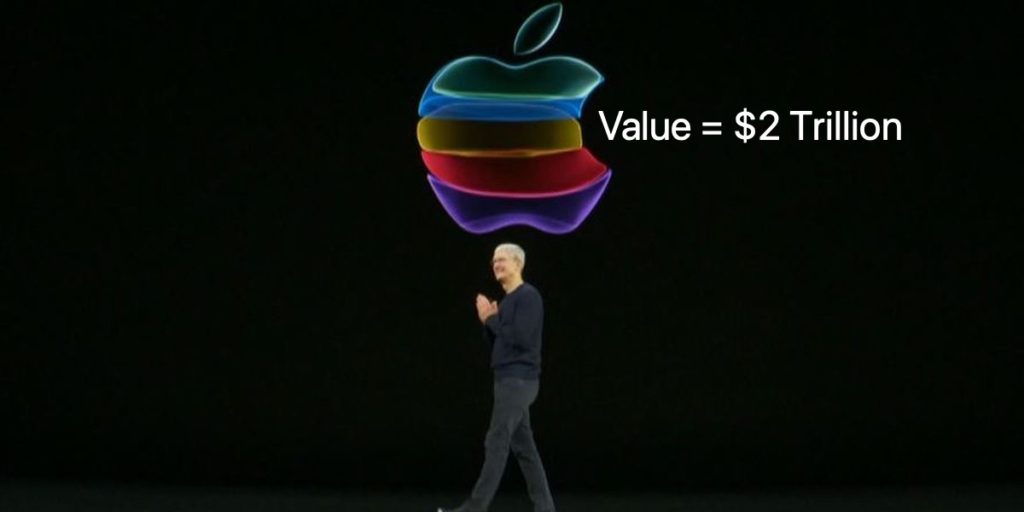Last week, Apple became the first US company to hit $2 trillion in market capitalization. It took Apple 42 years to reach $1 trillion in value and just two years after that to reach $2 trillion. Most of its second trillion came in the recent 21 weeks when the world is in lockdown, and the global workforce is at home. How does Apple manage to do this? Apart from Watch and Airpods, it has not launched an entirely new product line since Steve Jobs passed away in 2011. The short answer: it has a lot to do with having a monopoly, where one can call the shots, and consumers are locked in.
Apple has built a tight-knit ecosystem with its hardware, software, app store, and excellent supply chains. Its superbly designed phones, tablets, and computers with cutting-edge innovation attract hordes of consumers who swear by its products. It designs its hardware which is manufactured in other countries, where manufacturing costs (and taxes) are much lower than what they are in the United States.
These are complete devices with top of the line configurations, unprecedented innovation, and of course, design par excellence. Complete, in a sense, they come with all the software required for basic tasks, like editing photos, movies, and audio. A PC user has to pay for those separately, and that can add up to a lot. So users do not hold back from paying for all this value.
Take a step back, and you’ll see why Apple has consumers hooked. But how is it making money, when it has not launched any new product lines? Every September, Apple announces something “new.” And September is around the corner, so its consumers are anticipating a new iPhone model or MacBook or iMac desktop. But these are incremental upgrades with more memory, more cameras, higher resolution screen, new features in the OS, etc. Apple missed out on crucial innovations that others raced ahead to launch — electric cars, movie streaming, fitness bands, rockets that can land back on earth and be reused. Oh well, maybe Apple never intended to do rockets, but it did try electric cars.
Back to the core question: how does Apple do it?
Services, licensing fees, royalties
Apple is now turning its attention to services and can pitch those to millions of consumers who already bought its phones, computers, and watches. Services make these devices more versatile, just as PC owners thirsted for good software when the PC was introduced in the 198Os. For instance, Apple charges iPhone owners for backing up their data on its iCloud service. It charges for news. On the Android platform, equivalent services cost a fraction of what Apple charges — or are free. Compare the cost of iCloud storage to Google Drive storage, for instance. Apple gives only 5GB of free iCloud storage, whereas Google gives 15 GB free. Users could consume that 5 GB within the first year of purchase of the device–and run out. They would then have no other option but to pay Apple for additional storage to back up their phones on iCloud. Monthly and annual plans are offered.
Apple makes lots of money in royalties and licenses. Anyone outside Apple who wants to make accessories for its products (for instance, Belkin) or make apps for its sleek computing devices and phones — has to pay Apple hefty licensing fees.
So over the years, Apple has created its own ecosystem and locked in its consumers. It now has a monopoly within its ecosystem.
Other tech companies too!
Apple isn’t the only company to do this. Other examples are Microsoft, with its operating systems for PCs, and Blackberry with its high-security devices. When IBM created its personal computer in the early eighties, it did not have an operating system, the underlying software for running a computer. Microsoft did not have one either, though it told IBM that it could make an OS for its PC. In 1981, Microsoft went and bought an OS called QDOS (Quick and Dirty Operating System) from Seattle Computer Systems. It adapted it for the IBM PC and called it MS-DOS. From then on, Microsoft earned royalties on every IBM PC and clone sold. Then came Windows, and Microsoft continues to make money on royalties to this day for every PC sold. Yes, we have other operating systems like Ubuntu for PCs today, but these have a minuscule market share compared to Windows.
In that sense, Microsoft is a monopoly, and that has inflated its market valuation. Today Microsoft is heading to new territory — the Cloud — and is making its money from cloud computing services.
Blackberry may have still been around today, but it was slow to make touchscreen phones selling like hotcakes after Apple launched the iPhone. Ditto for another iconic smartphone maker, Nokia.
Conclusion
Anyone who can make a unique product today that is hard to copy (or is well protected by copyrights) will prosper. They have to create a repertoire of services around that product that will keep consumers hooked. And of course, they have to create something revolutionary that will change the world. Like the Sony Walkman, the iPod, the color TV, the automobile, the mobile phone, or reusable rockets that can take off and return to earth.

